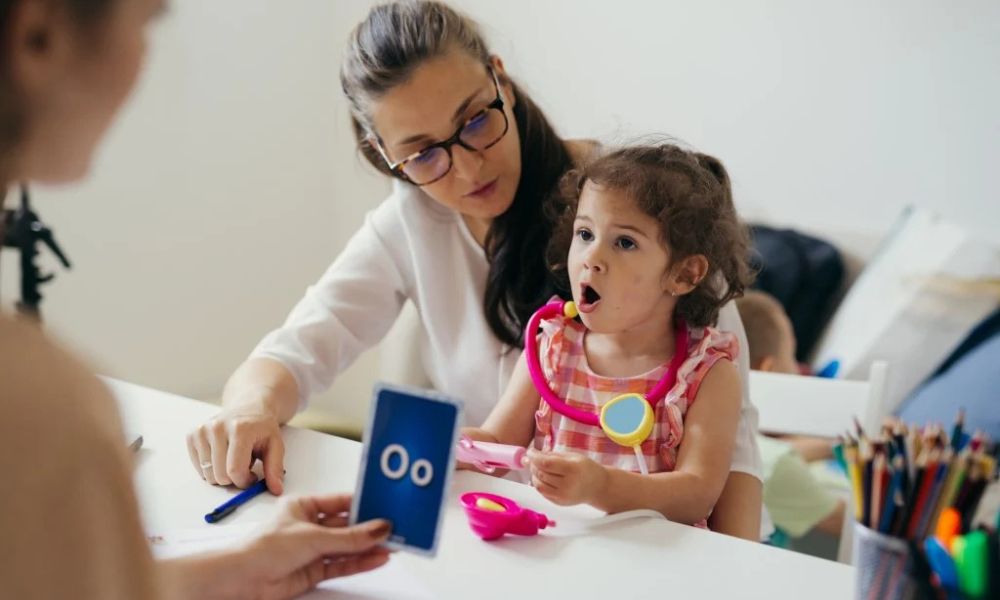Speech Delay in Toddlers: When to Worry and What to Do
Tanzeel Mehak
October 20, 2025

Worried about late words or unclear speech? This guide explains what a speech delay in toddlers looks like and the steps that help most.
Is your toddler using only a few words while other kids chatter during play dates and preschool? Do relatives struggle to understand their speech at home and outside, leaving you worried, second guessing milestones and unsure what to do?
You do not need guesswork or endless opinions from friends and forums when clear steps can guide each decision. Use age based milestones, a simple hearing check and daily practice to see progress and know when to call a speech language pathologist.
This guide explains what counts as a speech delay, when to act and what helps at home and in therapy. Keep reading to learn simple tests to request, practical play ideas and calm next steps you can start today.
What Speech Delay Means in Plain Words

Speech is how a child forms sounds and words with the mouth, while language is how a child understands and shares ideas. In practice, a speech delay in toddlers means missing expected milestones for words, sounds or simple phrases.
A late talker adds skills slowly but steadily, showing new words, better imitation and growing understanding across weeks, even if speech sounds unclear. A true delay shows missing skills and red flags, like few or no words by two, poor response to name or loss of earlier skills.
Milestones to Watch and Real Red Flags

Use simple checkpoints to track your toddler’s speech and language growth over time, then adjust expectations using the age ranges below. Focus on steady gains week by week, not on comparisons at playdates or preschool.
1. By 12 months
Responds to name, points or waves and babbles with rising and falling tone during play and routines. No gestures or no response to sound suggests concern and warrants a call to the pediatrician and a hearing check.
2. By 18 months
Uses simple words, imitates sounds and follows easy requests when paired with a gesture, like pointing to a cup or favorite toy. If only gestures or no imitation appear, schedule evaluation rather than waiting for a sudden leap.
3. By 24 months
Adds new words weekly, joins two words and follows simple directions during routines like meals, bath time and clean up. Only imitating or using words solely for basic needs signals a red flag that deserves timely assessment.
4. By 36 months
Speaks in many words and short sentences, with parents understanding most speech at home and familiar listeners understanding much of it. Very unclear speech or the absence of two word phrases by this age needs a professional check.
At any age, loss of skills, no response to name or no pointing to shared interest needs prompt evaluation. These signs may point to a speech delay in toddlers and deserve a timely hearing check and an SLP referral.
Common Causes and Risk Factors You Should Know
Several factors can lead to a speech delay in toddlers, so a clear plan keeps you from guessing. Some factors need medical checks, others improve with daily practice and simple changes at home.
- Hearing issues: Even mild hearing loss can blur speech sounds. Frequent ear infections matter. Ask for an audiology test. Clear results guide next steps and prevent months of guessing.
- Oral motor or mouth concerns: Trouble coordinating lips, tongue and jaw can block clear sounds and words. Tongue tie may limit movement for some sounds. An SLP or pediatric dentist can check this.
- Developmental and neurological conditions: Autism traits, language disorders, learning differences or cerebral palsy can affect speech. A speech language pathologist and your doctor can sort causes and build a plan that fits your child.
- History and environment: Prematurity, low birth weight, family history and limited back and forth talk raise risk. Caring parents do not cause delays. Rich daily interaction still speeds progress.
When to Call the Doctor and How Evaluation Works

Call your pediatrician if you suspect a speech delay in toddlers, especially with regression or inconsistent response to name. Bring a brief list of concerns, request a hearing check and mention any history of frequent ear infections.
A speech language pathologist checks understanding, expression, sound clarity and mouth movement through play, then turns results into a simple plan. Ask about early intervention before age three and school services after three, because earlier referrals usually bring faster progress.
Treatment That Helps Toddlers Catch Up
Speech therapy often closes the gap when there is a speech delay in toddlers. They use play and daily routines, then teach home practice so gains stick between visits.
Parent coaching is part of therapy, so you learn prompts, simple models and patient wait time during meals, bath and play. Treat underlying causes like hearing loss or mouth structure and add other therapies only when your team recommends them.
Daily Home Strategies That Make a Real Difference
Daily habits grow language faster than big events because practice happens often and feels easy.
Follow a good toddler development guide. Use meals, bath time and play as teaching moments, repeat useful phrases and invite short back and forth every day.
These habits support progress during a speech delay in toddlers without adding pressure.
- Talk and narrate: Describe what you do and see during chores, snacks and walks so words connect to real actions. Repeat the same simple phrases, like I pour water, you stir, to create predictable language patterns.
- Read, sing and play: Point to pictures, name items together and act out stories with toys to link sounds, words and meaning. Use short songs to practice turn taking, early sounds and new words in a fun, low pressure way.
- Expand their words: When your child says truck, respond with a slightly longer phrase like big truck or red truck drives down. Adding one or two words builds phrases without pressure and keeps the conversation moving forward.
- Give wait time: Ask a simple question, then pause for several seconds so your child can think, try and speak. Praise effort right away, not perfect words, because confidence encourages more attempts and faster progress.
- Limit screens: Choose face to face play and real conversations since toddlers learn language best through shared attention and quick back and forth. Short video chats with family can help because they include eye contact, turn taking and real responses.
Common Worries, Myths and What Not to Blame Yourself For
Bilingual homes do not cause speech delays; support both languages with clear talk, simple stories, songs and daily naming. Pacifiers and bottles may affect some sounds if overused; limit them during play and reading, since they are seldom the cause.
Boys sometimes start talking later on average, yet missing milestones or red flags still need attention and a timely evaluation. Caring parents do not cause delays; early checks, a hearing test when needed and steady home practice usually bring progress.
Final Encouragement
Small daily steps add up quickly when you repeat them inside simple, calm routines each day. If worries remain after watching milestones, call the pediatrician, request a hearing check and ask for a speech language pathologist referral.
Stay calm and consistent because your steady words, patient pauses and simple praise build confidence faster than complex drills. Trust your instincts, celebrate small wins and keep practicing every day, because you and your child can make strong, lasting progress.



